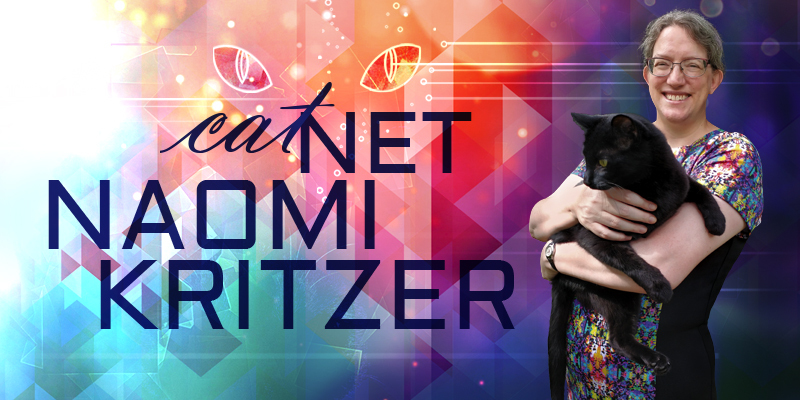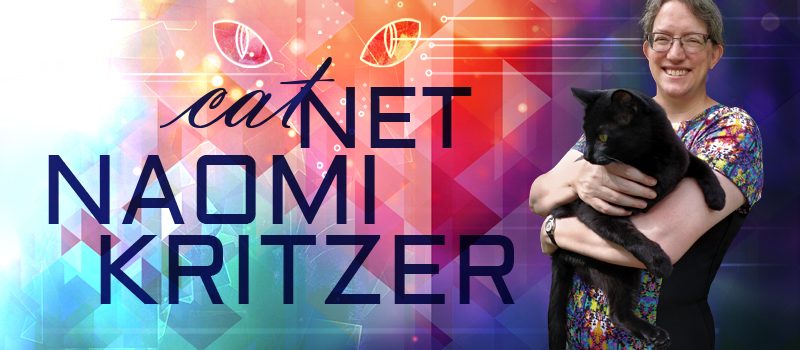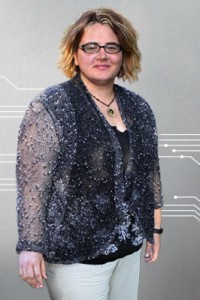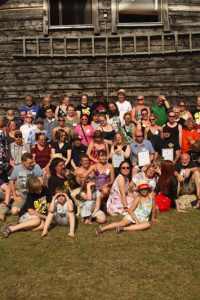Naomi Kritzer: CatNet

Naomi Katherine Kritzer was born April 23, 1973 in North Carolina and lived in Indiana and Texas before age five; she grew up in Madison WI and lived in London for a year at 13. She moved to Minnesota to attend Carleton College and remained there after graduating in 1995, settling in St. Paul. She is married with two children.
Kritzer’s first SF story was “Faust’s SASE” (1999), and she has published more than 30 stories, including several in the Seastead science fiction series, beginning with “Liberty’s Daughter” (2012). Her debut collection was Gift of the Winter King and Other Stories (2011).
As a novelist, her Eliana’s Song fantasy series began with Crawford Award finalist Fires of the Faithful (2002) and continued with Turning the Storm (2003). The Dead Rivers trilogy is Freedom’s Gate (2004), Freedom’s Apprentice (2005), and Freedom’s Sisters (2006).
Kritzer’s career entered a renaissance with Hugo Award winner and Nebula Award finalist “Cat Pictures Please” (2015), the centerpiece of collection Cat Pictures Please and Other Stories (2017). Her YA novel Catfishing on CatNet (2019) is set in the same world; it won a Lodestar Award, and was an Andre Norton Award finalist. A sequel, Chaos on CatNet, is forthcoming.
Excerpts from the interview:
“My parents were academics. My father is a political science professor, and my mother was a theater professor, so there was constant reading in my house, though a lot of it was for work. We had a house full of books. There was a corner of the living room with a shelf that included a bunch of children’s books, including the My Book House collection. My great-grandmother bought one of the very earliest editions for her children in the 1920s or ’30s. That set was behind the chair, and there was also a heat vent back there, so I would sit on the floor by the vent and the books and read. My parents stuck a little reading light back there for me. They found it weird that I wanted to sit on the floor, but I was like a cat – I was always cold in the winter, and I could sit by the vent and it would blow warm air on me.
“When I was nine or so, Madeleine L’Engle came to my town on a lecture circuit. I was a newspaper reader at a ridiculously early age, because I discovered that comics existed and then branched out from there. In the same section as the comics, the feature section, there was a little article about how Madeleine L’Engle was coming to town. I adored A Wrinkle in Time – it was my favorite book for years. I said, ‘Mom, I want to go!’ My mom said, ‘It’s not for children – it’s for adults, but I can take you if you don’t think you’ll be bored.’ We went, and it was actually a lecture, and the talk made very little impression on me. I just wanted to be in the presence of this person who had written something I loved so much. My mom told me later it was actually about how to become a writer – L’Engle talked about publishing short stories and getting an agent and things like that. All that went in one ear and out the other, because at that point I was not thinking about writing. I had a question I wanted to ask, though, so at the end when L’Engle said, ‘Are there any questions?’, my hand went up. Of course she called on me immediately, because I was the one child in the audience. I started to talk and every adult in the room turned around to see me. That made me so nervous my voice fell into a whisper and she couldn’t hear me, so she asked me to speak a little louder and I got even quieter. She had me come out to the aisle, and she came down off the podium and met me in the aisle, and we had a little conference. I asked her my question, and she told me the answer. She said ‘Is that it?’ I said, ‘Yes,’ and went back to my seat. That was it. But it was lovely. She also gave me a very straightforward answer. I had just read A Wind in the Door, and I wanted to know what happened to Progo at the end. She said, ‘He’s the wind at the end that blows the door open. That’s him coming back.’ I didn’t want the answer to be that the character had died, and it wasn’t exactly that. My mother was very impressed that L’Engle gave me a straight answer and didn’t say, ‘What do you think happened?’ She just told me. My encounter was a lovely thing – an illustration of how authors are people. My parents also write books, academic books, so the concept that books were written by actual people was something I took for granted from an early age.
“I first started writing stories in fourth grade. My school gave me an assignment every week of one or two pages of writing. I started writing a novel called Justin, the Horse with Blue Eyes – I still have it. It’s many dozens of pages. I don’t know if it’s up to 100, but I filled a lot of wide-rule notebooks with pencil. If Minicon had happened this year, they were going to do something I suggested, where writers pull out the absolute oldest piece of juvenilia they can find and then share it. I dug out mine and I read some of it myself. It’s a weird mix of ‘Wow, you can tell this child is going to someday be a writer,’ and, ‘Wow, this makes no sense at all.’ On page one or two there’s a character who sneaks into a barn in this summer camp in the middle of the night and hears a voice. She thinks, ‘Is the horse talking?’, because of course it’s a talking horse, and of course she knows that, because the author knows that. She goes straight to that conclusion instead of thinking, ‘Who’s in here with me?’, the normal sort of question you would ask if you sneaked into a barn in the middle of the night and heard somebody talking. Going straight to ‘Is that the horse?’ is a slight leap, but, you know, I was nine.
“As a kid I was very fond of games of ‘let’s pretend.’ Through most of elementary school I had no shortage of people to play with me, but then I got to middle school, and that’s a style of play that middle schoolers pretty much don’t engage in anymore. At that point I started writing stories down, because I was still making them up, and didn’t have the option to tell them to my friends and have them act out the stories with me. I wrote them down, and the first time I ever tried to submit a story I was 15, in high school. My first story acceptance was in 1999, so I was around 26.
“There was a period of time where I just collapsed as a writer, though. I sold five novels back in the early 2000s and finished up my trilogy. The trilogy did not sell super well, and then it finished right as the economy collapsed, and I wasn’t able to sell any more novels. I decided to try a different agent, but after I fired my agent, I couldn’t find a new one. There was a long period where I felt like I was never going to be able to sell a novel or book again. I was so depressed about that, I started also having a hard time submitting short fiction. I worry about people with books coming out in the pandemic, because I know a lot of people are just not reading now. They’re doomscrolling social media instead of reading. Even though they know reading would make them feel better, it requires a level of concentration that is really hard to summon when it feels like the entire world is on fire.
“I say I’m a science fiction and fantasy writer, because I write both. I wrote more fantasy for a while, but I’ve always written both. Of my recent stories, ‘Monster’ is science fiction, and ‘Little Free Library’ is fantasy; those are the two stories that came out this year. Writing the two genres is not super different. It’s hard to do a side-by-side comparison because the novels I wrote for Bantam were so long ago, and then I wrote a whole bunch of novels that didn’t sell. After that, I wrote Catfishing on CatNet. Catfishing was the first time I sat down with the intention of writing a YA novel from beginning to end. It wasn’t exactly the first time I wrote a YA novel, because the Seastead stories link together into what is basically a YA novel, but it was a very different writing experience. Writing YA felt more different to me than writing science fiction compared to fantasy. It’s funny, because my earliest novels would probably be marketed as YA if I sold them now, but they came out in 2001 or 2002, and while YA certainly existed then, there was a lot less genre YA, and it wasn’t as much of a marketing category.
“Sometimes, with science fiction I have to pay a little more attention to how the real world works than I do with fantasy. I write plenty of fantasy with a real-world grounding I have to pay some attention to, but I wanted Catfishing on CatNet to feel believably near future. I needed to make sure, if I had real locations, that they felt reasonably plausible. The TV show Max Headroom used to start with the line ’20 minutes into the future’ – that was sort of what I thought about while writing this, in terms of the setting. Obviously there’s stuff that doesn’t exist yet in the real world, like autonomous cars actually on the road, but I wanted the book to have that just-barely-over-the-horizon feeling.”
Read the full interview in the October 2020 issue of Locus.
 While you are here, please take a moment to support Locus with a one-time or recurring donation. We rely on reader donations to keep the magazine and site going, and would like to keep the site paywall free, but WE NEED YOUR FINANCIAL SUPPORT to continue quality coverage of the science fiction and fantasy field.
While you are here, please take a moment to support Locus with a one-time or recurring donation. We rely on reader donations to keep the magazine and site going, and would like to keep the site paywall free, but WE NEED YOUR FINANCIAL SUPPORT to continue quality coverage of the science fiction and fantasy field.
©Locus Magazine. Copyrighted material may not be republished without permission of LSFF.








